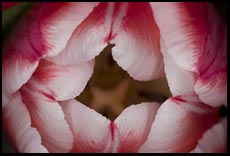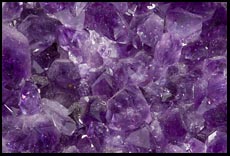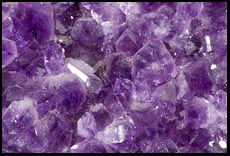
Canon Macro Ring Light and Twin Light
by Philip Greenspun; created February 2008
Site Home : Photography : MR-14EX and MT-24EX strobes

by Philip Greenspun; created February 2008
Site Home : Photography : MR-14EX and MT-24EX strobes
Canon makes two similar macro flash systems, the MR-14EX Ring Lite and MT-24EX Twin Flash. Both are intended to surround the front of a standard Canon macro lens, e.g., the Canon 100/2.8, which is the lens used for all of the example images here.
The MR-14EX Ring Lite has two tubes forming a ring around the front of the macro lens. This will be a reasonably diffuse light source if the object to be photographed is small, e.g., less than four inches in width. Ring lights are among the most uniform light sources, producing shadowless images with little variation from photographer to photographer. As such, they are the standard for much medical photography.
The MT-24EX Twin Lite is basically the same hardware, but the two strobes are packaged into mini shoe-mount boxes. These can be packed on either side of the lens, in which case the light is similar to that from a ring light. They can be angled. One or both strobes can be held off-camera. The MT-24EX offers much more creative control of light at some risk of operator error.


Both of these units are designed to work with any Canon EOS macro lens, including the big 180mm macro, which requires the Macro Lite Adapter 72C. These units also work with the Canon MP-E 65mm lens.
Here are a couple of typical ring flash photos, both taken with the 100/2.8 macro. These are the kinds of pictures you might expect a doctor's assistant to create. Notice the reflection of the ring flash itself in the subject's eye.
Suppose that you discover that your $5000 Rolex is less accurate than a $10 Timex. You decide to sell it before it needs another $500 cleaning. Let's try a couple of images first with the MR-14ex ring flash. Note that the first image required exposure compensation of +2/3 f-stop and the second, due to the glare from the crystal, required reverting to manual flash at 1/32nd power. Both are with the 100mm lens at f/11. Adjusting relative power between the ring light tubes did not reduce the glare, only shifted it around.
Here is the same subject with the MT-24ex twin light. Automatic exposure, compensated +2/3, worked fine for this and glare from the crystal was not a problem. For the first image, the two strobes remained mounted to the ring. For the second image, also including the entire watch, one strobe was handheld above the subject pointing straight down. This brightened the background a bit.
Suppose that you had been saving a treasured Canonet QL17 compact 35mm film camera as a 16th birthday gift for your beloved first-born child. Upon reaching that age of wisdom, he scorns the gift saying "What's wrong with you, gramps? Where do you think I could ever buy film for that thing? Do you really want to destroy the environment with chemicals anyway? All the cool kids use cell phone cameras." Time to sell the camera on eBay! 65 Below are a couple of images with the MR-14EX Ring Lite. Note the uneven illumination.
Switching to the MT-24EX Twin Lite and keeping both strobes on the lens ring, we get very similar images:
Holding one strobe of the MT-24EX Twin Lite off camera results in substantially more even light:
Both macro strobes provide for an adjustable output ratio between the two tubes. The effect of a 4:1 ratio is much more dramatic with the Twin Lite than with the Ring Lite. Here is a series of Twin Light images, at 1:1, 1:4, and 0:1 (only the right tube firing). All were taken with the 100/2.8 USM lens at f/16 and a magnification of 1:1.
Here are some images with the Canon MP-E 65mm, a truly bizarre lens.
The basis of both of these macro strobes is a big power pack that mounts into any Canon EOS body's hot shoe. The power pack design appears to have been lifted from the standard EOS system speedlites. The switches and display are more or less the same. The features are the same, including ones that wouldn't seem to be useful in a macro strobe, such as second curtain sync, high-speed sync, and exposure bracketing. The battery compartment holds four AA cells and there is a jack for an external power pack.
The main physical difference between the power pack for these stobes and a standard EOS strobe is that there is no actual strobe lamp. One or two cables come out from the power pack to attach to the strobe tubes at the front of the lens.
These are powerful flashes. Unfortunately, in macro work that is not necessary a good thing. Despite that nobody taking macro photos is going to think in terms of guide number, Canon specifies the flash power as if these were conventional on-camera strobes. The Twin Light has a guide number of 85 in feet at ISO 100. This means that, at a distance of 20', a properly exposed photo could be taken at ISO 100 and f/4 (divide guide number by distance to get aperture).
Unless the aperture is set to a fuzzy-from-diffraction f/32, which becomes f/64 when a macro lens is racked out to 1:1, such an abundance of power is typically unnecessary for macro work. A more interesting question is how little power the flash can be set to put out. At optimum sharpness apertures around f/8 and a subject that is only a few inches from the lens, a huge blast of light is not required, especially at ISO settings or film higher than 100. The owner's manual (disappointingly not available online) includes a table of workable magnifications and apertures. At ISO 400 with a 100mm lens, for example, the MR-14EX ring light is overpowered at f/2.8 through f/8. At ISO 100, the flash should work for all magnifications between 0.33 and 1 and all apertures between f/2.8 and f/32. In manual mode, the minimum flash output is 1/64th of full power, i.e., six f-stops less than full power.
Both macro strobes can control an off-camera EX-series EOS speedlight wirelessly. The command sequence to do this is complex enough that you will need to bring the owner's manual with you, but it should work well once configured. The off-camera strobe will be useful for background illumination.

The cheapest and simplest alternative to this system is a standard flash, an off-camera cord, and a white reflecting card. The image at right was taken with a Canon MP-E 65mm lens and just such a setup.
For taking pictures of small objects, a superior light source is often a softbox (see my studio photography primer) or a full light tent. These are the standard ways to get uniform shadowless illumination. Below are a couple of images taken with a small softbox on a portable strobe, held off-camera with a Canon cord.
The MR-14EX Ring Lite is the best choice if you need a consistent series of shadowless photos of small objects, especially if the photographers are going to be inexperienced. The MT-24EX is a better choice for creative projects.

|
Amethyst very close to 1:1. The image at left is with the ring flash; the image at right with the twin flash. |

|
Text and pictures copyright 2008 Philip Greenspun. Unless otherwise noted, all images on this page were taken with a full-frame Canon EOS 1Ds III and 100mm macro lens.